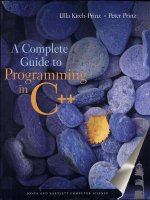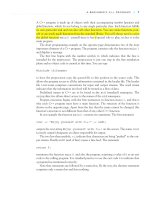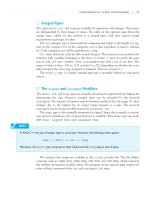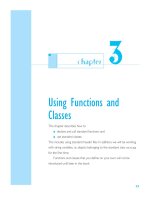A Complete Guide to Programming in C++ part 36 pps
Bạn đang xem bản rút gọn của tài liệu. Xem và tải ngay bản đầy đủ của tài liệu tại đây (202.72 KB, 10 trang )
CLASS ARRAYS
■
329
ᮀ Declaring Class Arrays
Array elements can also be objects of a class type. The array is known as a class array in
this case. When you declare an array of this type, you only need to state the type of the
array elements.
Example: Result temperatureTab[24];
This statement defines the class array temperatureTab that stores 24 objects of type
Result. This class was introduced at the beginning of the last chapter.
As the statement does not initialize the array explicitly, the default constructor is
automatically called for each array element.
Thus, the previous example is only valid for the first version of the Result class as
this class contains a default constructor.
ᮀ Explicit Initialization
A class array is initialized as usual by an initialization list. The list contains a constructor
call for each array element.
Example: Result temperatureTab[24] =
{
Result( -2.5, 0,30,30),
Result( 3.5), // At present time
4.5, // Just so
Result( temp1), // Copy constructor
temp2 // Just so
};
The first five array elements are initialized by the constructor calls implicitly contained
in these statements. Instead of using a constructor with one argument, you can simply
supply the argument. The default constructor is then called for the remaining elements.
If the size of an array is not stated explicitly, the number of values in the initialization
list defines the size of the array.
The public interface of the objects in the array is available for use as usual.
Example: temperatureTab[2].setTime( 2,30,21);
No additional parentheses are needed in this statement since the subscript operator []
and the class member operator . are read from left to right, although they have the same
precedence.
Class arrays can only be defined without explicit initialization if a default constructor exists for the class.
✓
NOTE
330
■
CHAPTER 16 ARRAYS
// multidim.cpp
// Demonstrates multidimensional arrays.
//
#include <iostream>
#include <iomanip>
using namespace std;
char representative[2][20] = {"Armstrong, Wendy",
"Beauty, Eve"};
// Each representative has five different
// articles available, having sold the following:
int articleCount[2][5] = { { 20, 51, 30, 17, 44},
{150, 120, 90, 110, 88}
};
int main()
{
for( int i=0; i < 2; i++ )
{
cout <<"\nRepresentative: " << representative[i];
cout << "\nNumber of items sold: ";
for( int j = 0; j < 5; j++ )
cout << setw(6) << articleCount[i][j];
cout << endl;
}
return 0;
}
■
MULTIDIMENSIONAL ARRAYS
Sample program
Screen output:
Representative: Armstrong, Wendy
Items sold: 20 51 30 17 44
Representative: Beauty, Eve
Items sold: 150 120 90 110 88
MULTIDIMENSIONAL ARRAYS
■
331
ᮀ Defining Multidimensional Arrays
In C++ you can define multidimensional arrays with any number of dimensions. The
ANSI standard stipulates a minimum of 256 dimensions but the total number of dimen-
sions is in fact limited by the amount of memory available.
The most common multidimensional array type is the two-dimensional array, the so-
called matrix.
Example: float number[3][10]; // 3 x 10 matrix
This defines a matrix called number that contains 3 rows and 10 columns. Each of the 30
(3 ϫ 10) elements is a float type. The assignment
Example: number[0][9] = 7.2; // Row 0, column 9
stores the value 7.2 in the last element of the first row.
ᮀ Arrays as Array Elements
C++ does not need any special syntax to define multidimensional arrays. On the con-
trary, an n-dimensional array is no different than an array with only one dimension
whose elements are (n–1)-dimensional arrays.
The array number thus contains the following three elements:
number[0] number[1] number[2].
Each of these elements is a float array with a size of 10, which in turn forms the rows of
the two-dimensional array, number.
This means that the same rules apply to multidimensional arrays as to one-dimen-
sional arrays. The initialization list of a two-dimensional array thus contains the values of
the array elements, that is, the one-dimensional rows.
Examples: int arr[2][3] = { {5, 0, 0}, {7, 0, 0} };
int arr[][3] = { {5}, {7} };
These two definitions are equivalent. When you initialize an array, you can only omit
the size of the first dimension. It is necessary to define any other dimensions since they
define the size of array elements.
ᮀ The Example on the Opposite Page
The program opposite defines the two-dimensional arrays representative and
articleCount, which have two rows each. The representative[i] rows are
char arrays used for storing the names of the representatives. You can also use a one-
dimensional string array.
Example: string representative[2] = {"La ","Fo "};
332
■
CHAPTER 16 ARRAYS
// telList.h
// Class TelList to represent a list
// containing names and telephone numbers.
//
#ifndef _TelList_
#define _TelList_
#include <string>
using namespace std;
#define PSEUDO -1 // Pseudo position
#define MAX 100 // Maximal number of elements
// Type of a list element:
struct Element { string name, telNr; };
class TelList
{
private:
Element v[MAX]; // The array and the current
int count; // number of elements
public:
TelList(){ count = 0;}
int getCount() const { return count; }
Element *retrieve( int i )
{
return (i >= 0 && i < count)? &v[i] : NULL;
}
bool append( const Element& el )
{
return append( el.name, el.telNr);
}
bool append( const string& name,
const string& telNr);
bool erase( const string& name);
int search( const string& name);
void print();
int print( const string& name);
int getNewEntries();
};
#endif // _TelList_
■
MEMBER ARRAYS
Class TelList
MEMBER ARRAYS
■
333
ᮀ Encapsulating Arrays
A programmer often needs to handle objects of the same type, such as company employ-
ees, bank accounts, or the articles in stock. A class designed to perform this task can use
an array for ease of data management. An array allows you to access individual objects
directly and perform searches.
A class that encapsulates an array will provide methods for simple array operations,
such as inserting and deleting objects. When you design a class of this type, one aim will
be to perform automatic range checking. This helps avoid overrunning the end of an
array when performing read or write operations. The resulting class will contain a com-
fortable and safe interface for object data management.
ᮀ The Class TelList
The class TelList on the opposite page is designed to manage a simple telephone list.
Each entry in the list contains a dataset containing a name and a phone number. The
Element type, which comprises two strings, was defined for this purpose. The array v
can store up to MAX entries of the Element type. The data member count records the
number of elements currently stored in the array. When a phone list is created, this num-
ber will initially be 0. When an element is inserted or deleted, the number is modified
correspondingly.
The TelList class uses a single default constructor that sets the counter, count, to
zero. It is not necessary to provide an initial value for the MAX elements in the array v
since the default constructor of the string class is executed for all strings.
The tasks performed by the other methods are easily deduced from their names. The
retrieve() method returns to a given index a pointer to the corresponding element.
Using a pointer makes it possible to return a NULL pointer if the index is invalid.
The append() methods add a new entry to the list. The data passed to a method is
copied to the next free array element and the counter is incremented. If there is no space
available, the name field is empty, or the name is already in use, nothing happens. In this
case, the method returns false instead of true.
The exercises for this chapter contain further details on these methods. You can
implement the methods for the TelList yourself and go on to test them.
exercises
334
■
CHAPTER 16 ARRAYS
Original array:
After the first loop:
After the second loop:
100 50 30 70 40
50 30 70 40 100
30 50 40 70 100
second largest element
largest element
0123456789 . . .
. . .
falseArray
Index
false true true false true false true false false
* * B R E A K * * * *
Press interrupt key to terminate (^C)
The output of a scrolling string has to be performed at the same cursor position.
The screen control characters make it possible to locate the cursor, and that
independent of the current compiler (see appendix).
✓
NOTE
■
EXERCISES
Example of a bubble sort algorithm
Sieve of Eratosthenes
For this task you can define an array of boolean values in which each element is
initially
true.To eliminate a number n you simply set the n
th
element in the array
to
false.
Result:
Screen shot of exercise 4
EXERCISES
■
335
Use the bubble sort algorithm to sort the array. This algorithm repeatedly accesses the array, comparing
neighboring array elements and swapping them if needed. The sorting algorithm terminates when there
are no more elements that need to be swapped. You use a flag to indicate that no elements have been
swapped.
✓
NOTE
Exercise 1
Write a C++ program that reads a maximum of 100 integers from the keyboard,
stores them in a
long array, sorts the integers in ascending order, and displays
sorted output. Input can be terminated by any invalid input, such as a letter.
Exercise 2
Chapter 14 introduced the sample class DayTime and the isLess() method.
Define and initialize an array with four
DayTime class objects.
Then write a
main function that first uses the print() method to display the
four elements. Finally, find the largest and smallest elements and output them on
screen.
Exercise 3
Write a program that outputs all prime numbers less than 1000.The program
should also count the number of prime numbers less than 1000.An integer >= 2
is a prime number if it is not divisible by any number except 1 and itself. Use the
Sieve of Eratosthenes:
To find primary numbers simply eliminate multiples of any primary numbers
you have already found, i.e.:
first eliminate any multiples of 2 ( 4, 6, 8, ),
then eliminate any multiples of 3 ( 6, 9, 12, ),
then eliminate any multiples of 5 ( 10, 15, 20, ) // 4 has already been eliminated
and so on.
Exercise 4
Write a C++ program to create the screen output shown opposite.The
following banner
* * * B R E A K * * *
is to be displayed in the center of the window and scrolled left.You can scroll
the banner by beginning string output with the first character, then the second,
and so on. Handle the string like a loop where the first letter follows the last
letter and output continues until the starting position is reached.
You can use a wait loop to modify the speed of the banner after each string is
output.
336
■
CHAPTER 16 ARRAYS
bool append( const string& name,
const string& telNr);
bool erase( const string& name);
int search( const string& name);
void print();
int print( const string& name);
int getNewEntries();
***** Telephone List *****
D = Display all entries
F = Find a telephone number
A = Append an entry
E = Erase an entry
Q = Quit the program
Your choice:
Exercise 5
Methods to be implemented for the TelList class
Menu of the application program
EXERCISES
■
337
The phone list will not be stored permanently in a file. This is just one of the enhancements (another
would be variable length) that will be added at a later stage.
✓
NOTE
Exercise 5
The sample class TelList was introduced in this chapter; however, some
methods still need to be implemented and tested.
■ Implement the TelList class methods shown opposite.
The name is used as an unambiguous key.This means the
append()
method can only be used to append an entry provided the name is nei-
ther blank nor already in use.
The method
erase() deletes an array element.The position of the ele-
ment to be deleted is first located using the
search() method. If the ele-
ment does not exist,
erase() returns a value of false. In any other case,
the last element in the array is used to overwrite the element that is to
be deleted and the counter
count is decremented.
The
search() method finds the position in the array that contains the
search name. If the search operation is unsuccessful, the value
PSEUDO is
returned.
The
print method without parameters outputs all available entries.You
can pass the first letter or letters of a name to the second method to
output any entries beginning with these letters. Use the method
com-
pare()
from the string class to help you with this task.
Example:
str1.compare( 0, 5, str2) == 0
This expression is true if the five characters subsequent to position 0 in
the strings
str1 and str2 are identical.
The
getNewEntries() method is used to read new phone list entries
from the keyboard. Each new entry is appended using the
append()
method. Reading should be terminated if the user types an empty string.
The method returns the number of new entries.
Write an application program that creates a phone list of type
TelList
and displays the menu shown on the opposite page.
■ The menu must be placed in a function of your own that can return the
command input.The menu must be called in the main loop of the pro-
gram. Depending on the command input, one of the methods defined in
the class
TelList should be called. If the menu item “Erase” or “Search”
is chosen, you must also read a name or the first letters of a name from
the keyboard.
solutions
338
■
CHAPTER 16 ARRAYS
■
SOLUTIONS
Exercise 1
//
// bubble.cpp
// Inputs integers into an array,
// sorts in ascending order, and outputs them.
//
#include <iostream>
#include <iomanip>
using namespace std;
#define MAX 100 // Maximum number
long number[MAX];
int main()
{
int i, cnt; // Index, quantity
cout << "\nS o r t i n g I n t e g e r s \n"
<< endl;
// To input the integers:
cout << "Enter up to 100 integers \n"
<< "(Quit with any letter):" << endl;
for( i = 0; i < MAX && cin >> number[i]; ++i)
;
cnt = i;
// To sort the numbers:
bool sorted = false; // Not yet sorted.
long help; // Swap.
int end = cnt; // End of a loop.
while( !sorted) // As long as not
{ // yet sorted.
sorted = true;
end;
for( i = 0; i < end; ++i) // Compares
{ // adjacent integers.
if( number[i] > number[i+1])
{
sorted = false; // Not yet sorted.
help = number[i]; // Swap.
number[i] = number[i+1];
number[i+1]= help;
}
}
}









